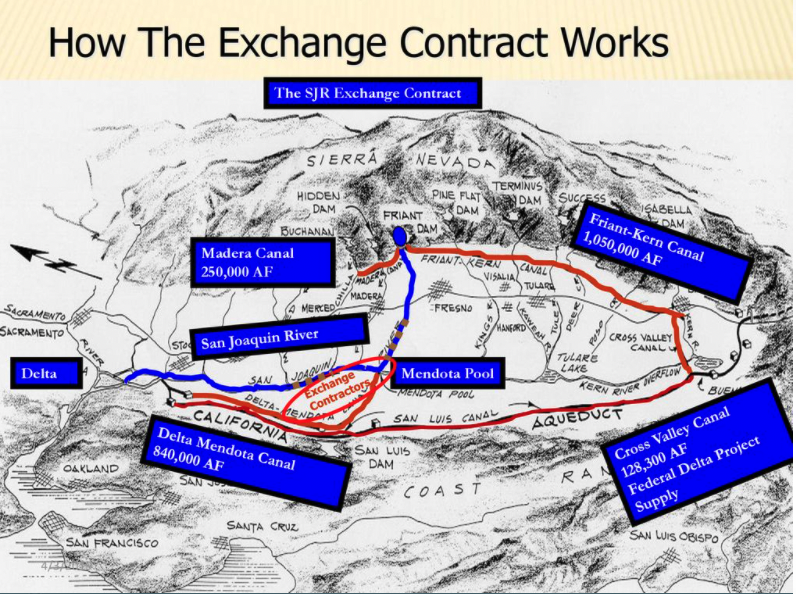Even as most agricultural water supplies are being cut to the bone with California descending into a third year of extreme drought, the San Joaquin River Exchange Contractor districts will apparently receive 100% of their “critical year” allotment – 650,000 acre feet.
The move is just one of the quirks in California’s byzantine world water rights.
The federal Bureau of Reclamation has increased the amount of water coming out of the Friant Dam above Fresno to help satisfy its contract with the Exchange Contractors. That water normally goes to Friant Water Authority and its member agencies which are spread more than 150 miles up and down the east side of the San Joaquin Valley. Calls to the Authority weren’t returned.
The Friant Dam is part of the Central Valley Project, a more than 400-mile network of federal canals and dams that transport water to farms and towns throughout the San Joaquin Valley. But different agencies have different rights when it comes to the federal water.
The Exchange Contractors are four agricultural water districts that extend from Newman down to Firebaugh on the west side of the valley. When the federal government built the Central Valley Project in the 1930s, it took San Joaquin River water from existing water users and moved it to Friant contractors in the southern part of the valley. In “exchange,” the federal government promised the original river users water from the Sacramento-San Joaquin Delta. That promise carries on today and the Exchange Contractors have a strong entitlement to water based on their government contract.
But extreme drought conditions mean there isn’t enough water in the delta to satisfy that contract. So, water being held behind Friant Dam is being sent to the Exchange Contractors instead. On April 1, Friant Dam releases increased from 680 cubic feet per second to 930 cfs to meet the Exchange Contractors’ needs, according to a Reclamation press release. That amount will increase into the spring. Over the summer, releases will exceed 1,700 cfs.
Reclamation slashed water supplies for most others in the state. The Sacramento Valley Settlement Contractors are getting 18% of their allocation and south of delta and north of delta irrigators are getting 0%.
Friant contractors were told they would receive 15% of their 800,000 acre feet contract which will go to “Class 1” water users. The relatively low 15% allocation was decided on so Reclamation could hold water for the Exchange Contractors in case there wasn’t enough coming from the delta.
But that 15% allocation could dwindle away to even less, wrote Fergus Morrissey, general manager of Friant contractor Orange Cove Irrigation District, in an email. Flows will, “increase as the demand for water by the Exchange Contractors ramps up heading into the irrigation season,” he wrote.
“We’re thinking about there being some change in it because of this action,” said Michael Jackson, area manager for the Bureau of Reclamation’s south central California area office, on the potential decrease in Friant’s allocation.
The flows for the Exchange Contractors could last until September, he added.
“We’ll do our due diligence to meet our obligations under the exchange contract,” said Jackson. “This year is so dry, I don’t do promises anyway, but no guarantees.”
Friant Dam water is rarely taken for the Exchange Contractors. But it has happened before in 2014/15 when Friant received a 0% allocation so Reclamation could satisfy the Exchange Contractors’ water supply. That decision resulted in Friant users suing the federal government, a lawsuit that is still ongoing.
“It hasn’t happened very many times over the years,” said Kole Upton, farmer and chairman of Friant contractor Chowchilla Water District, on Friant Dam water going to the Exchange Contractors. “But it is part of the lexicon that we deal with so it’s not something that was unexpected for us.”
The lack of surface water means farmers will turn to pumping groundwater to sustain their crops, said Upton.
“It’s going to cause the underground to drop more,” he said.
That could be a major problem for small disadvantaged communities such as Fairmead, where crops surround the town’s homes as far as the eye can see. In the summer of 2021, small communities saw groundwater levels plummet and domestic wells go dry as surrounding agriculture sucked up the aquifers.
“They’re embedded in our district,” said Upton on disadvantaged communities. “They get water when we get water. It replenishes their underground.”
And even though the state’s Sustainable Groundwater Management Act, which aims to bring groundwater back to sustainable levels, has started to take effect, the process is slow going and sustainability isn’t required until 2040. Many irrigation districts aren’t implementing any pumping restrictions.
Share this:
- Click to share on Facebook (Opens in new window)
- Click to share on Twitter (Opens in new window)
- Click to share on LinkedIn (Opens in new window)
- Click to share on Reddit (Opens in new window)
- Click to share on Tumblr (Opens in new window)
- Click to share on Pinterest (Opens in new window)
- Click to share on Pocket (Opens in new window)
- Click to share on Telegram (Opens in new window)
- Click to share on WhatsApp (Opens in new window)
- Click to print (Opens in new window)








